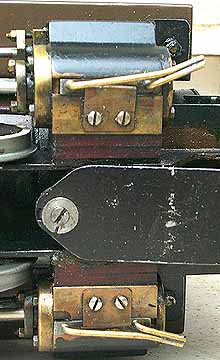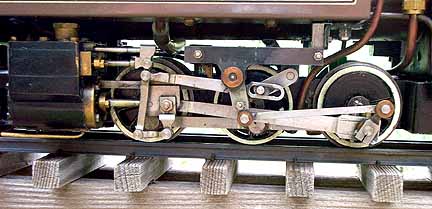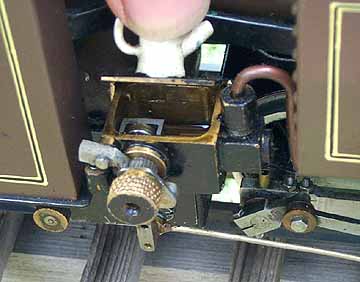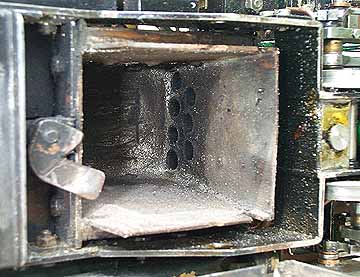
Back to Sidestreet Bannerworks
June 2003
Hugh Saunders’ coal-fired 2-6-2T
by Marc Horovitz

During WW1, the best way to get supplies to the troops quickly, and to move the wounded behind the lines, was via light, semi-portable railways. A vast network of these was built in France on both sides of the line. The British War Department ordered a large number of 2'-gauge locomotives from US builders Alco and Baldwin. The Baldwin's were mostly 4-6-0Ts while the Alco locomotives, of similar size, were 2-6-2Ts. After the war, many of these locomotives remained in France to help rebuild the country. One of this class survives today as Mountaineer on the Ffestiniog railway in Wales and another is running in France on the Petit train de la Haute Somme—APPEVA.
The model
This locomotive is faithful to the prototype in proportion and major points. The detail level is relatively low (even boiler bands are absent), but mechanically, the locomotive is first rate. The engine sports a mechanical lubricator just forward of the cab and driven off the right expansion link. The valve gear is superb -- full Walschaerts, with each piece beautifully milled from the solid, not cut out of sheet metal. The only drawback is that it is operated by a screw reverser in the cab -- a real nuisance, but probably prototypical. The side tanks are functional and are joined by a balance pipe under the boiler. There is a pump in the left tank that is tied in with the engine's feedwater system. There is a second pump, driven from the middle axle via an eccentric and a scotch yoke. A bypass valve is activated by a handle in the cab.
The backhead is fully fitted, with a water glass, blower valve, throttle, pressure gauge, and whistle valve. The whistle (which really isn't very good) is located under the footplate on the left side of the locomotive. Cylinders are fitted with working drain cocks that can be turned on and off via a sliding plate beneath each cylinder. Condensate is exhausted forward, as per British practice.
The best part, though, is that this engine is coal fired. It is fitted with a locomotive-type boiler with seven flues. The firebox, for an engine of this size, is quite large, making it relatively easy to keep a fire going. The smokebox front slides off for easy access to the large smokebox for cleaning out the ash and sweeping the flues.
Alas, I know little of Hugh Saunders, the builder. I have seen several examples of his work and all are superb. His engines rarely come up for sale, which suggests either a limited output or that all of his engines are well loved and tightly kept. I know that he passed away a few years ago, but I know nothing of his life or the scope of his work. If anyone reading this can fill in the blanks, I would be grateful. Please e-mail me.
The run
Operating a coal-fired locomotive is a different experience from running any other type of steam engine. Even with the best of engines (and this one would certainly fall into that category), it takes a lot longer before you are ready to go and you must keep a constant eye on the fire, the pressure gauge, and the water level.
Even though the engine had been well cleaned from the last run, I ran the flue brush through the flues for good measure and blew out the smokebox with compressed air. I then oiled the engine all round and filled the mechanical lubricator with steam oil. I filled the tanks with distilled water and began pumping water into the boiler with the hand pump. I could hear the little balls rattling inside the clacks with each stroke. The pump worked very easily, which did not bode particularly well. There should have been some resistance. However, the water came up in the glass as expected.
I then filled the firebox with nuggets of charcoal soaked in kerosene. I dropped the fan into the stack and lit the fire. There was copious smoke from the kerosene, very atmospheric. Charcoal tends to burn down pretty rapidly, so I had to keep adding it to keep the fire going while pressure came up to about 25 pounds. Once this was achieved, the fan was set aside and the engine's blower turned on. With the charcoal glowing nicely and the pressure continuing to rise, I slowly started switching over to anthracite. If you pile too much coal on all at once, you can kill the fire in short order. Changing over is a gradual process. Almost right away, though, I could smell that wonderful coal aroma. This is what it's all about!
There is a red line on the pressure gauge at 50 psi, and this is where the safety valve lifted. The fire was still running partially on charcoal, so I had to keep tending it until it was fully burning coal. Once that was done, it was time to go!
I opened the draincocks by pushing the little plates forward, then opened the throttle. Water came spurting out the tiny drain pipes. After a few seconds, this turned to steam, but the engine showed little inclination to move. I closed the drain cocks and that did the trick. The engine moved smoothly off, running at a reasonable rate. It was quite controllable.
After a couple of laps I added some more coal to the fire and saw that the water was getting low. I closed the bypass valve in the cab to let the axle pump refill the boiler and let it go another lap. However, water failed to rise in the glass. I tried the hand pump, which by this time should have been pumping against the boiler pressure. Unfortunately, though, it was still working very easily. I opened the bypass valve to see what would happen and tried the hand pump again. It pumped water back into the tank, which suggested that the check valves were doing their part. I suspect that the O-ring on the pump ram is so worn that it isn't making a good enough seal to pump the water against the pressue of the boiler. With no way to get water into the boiler, I had no choice but to drop the fire and end the run. Oh, well. Even good engines have bad days.
.
|
|
|
| Builder | Hugh Saunders (England) |
| Date built | 1980s (?) |
| Gauge | 0 (32mm) |
| Scale | 16mm = 1'-0" |
| Boiler | Locomotive type, seven flues, unsuperheated |
| Fittings | Throttle, whistle, blower, safety valve, pressure gauge |
| Fuel | Coal |
| Blow-off pressure | 50 psi |
| Cylinders | Two, double-acting D-valve |
| Reversing gear | Walschaerts, screw reverser |
| Lubricator | Mechanical |
| Dimensions | Length, 12-7/8"; width, 4-1/4"; height, 6" |
| Additional features | Axle pump, pump in side tank, feedwater bypass system, working drain cocks, snap-off trailing truck for access to firebox |




Left: Working drain cocks. These are little sliding plates that open and close the cocks. The upper one is in the open position while the bottom one is closed.









Back to Sidestreet Bannerworks home page
This page and its contents
Copyright Sidestreet Bannerworks, 2003